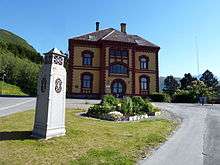Museum Nord, Narvik

The Museum Nord, Narvik is a museum in Narvik, Norway. The museum is an Anchor point on the European Route of Industrial Heritage.[1]
Context
Narvik, was founded in 1902 as the railhead of the Ofoten railway at an ice-free port on the Ofotfjorden. The town was named after the previous farm. LKAB, the mining corporation, exports the limitless supply of iron ore from Kiruna in neighbouring Sweden. The Swedish company (Gällivarre Aktiebolag) built a railway to Narvik, as the port there is ice-free thanks to the warm Gulf Stream, and is naturally large, allowing boats of virtually any size to anchor, up to 208 metres (682 ft) long and 27 metres (89 ft) deep.[2][3]
It has transported more than a thousand million tons of Swedish iron ore 1902. Each train carries 6,800 tonnes of ore in 68 wagons. Each axle has a carrying capacity of 30 tonnes. Narvik was heavily bombed in World War II, and the harbour was blocked by sunken ships. These were cleared and business re-commenced.
The museum is situated a kilometre from the harbour and contains models of significant bridges and landing stages.[1]
References
- Notes
- Footnotes
- 1 2 "ERIH: Museum Nord - Narvik". European Route of Industrial Heritage. 2014. Retrieved 15 January 2015.
- ↑ "Key facts about Narvik". VisitNorway.com. Retrieved 2008-11-24.
- ↑ "Narvik, Norway". BBC. Retrieved 2008-11-24.
External links
Coordinates: 68°25′54″N 17°25′16″E / 68.4316°N 17.4210°E
| Wikimedia Commons has media related to Museum Nord. |
